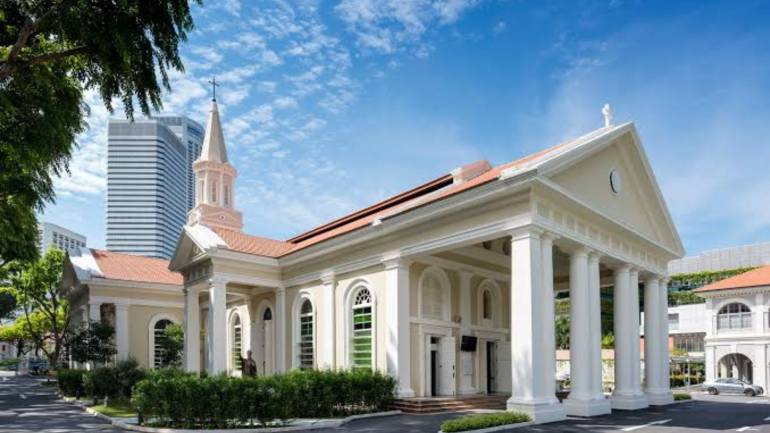Singapore's Good Shepherd Cathedral: Served as Emergency Hospital During World War II

This beauty of a church in Singapore was turned into a hospital, sheltering the sick and the wounded during World War II.
The Imperial Japanese occupied this island and city-state after defeating the British.
Singapore was renamed Syonan-to, meaning 'Light of the South Island.'
The origin of the Good Shepherd Cathedral can be traced to more or less 1930, before the war. At the time the Catholics in Singapore worshiped at the house of Denis Lesley McSwiney, the architect who designed the cathedral.
In 1932, the community started to build a mix of wood and nipa a chapel. It measured 60 feet long and 30 feet wide.
The chapel was completed in the following year with an estimated cost of 700 Spanish dollars.
Since it was a wooden and attap religious structure, it was built without a tower and a spire, which strong winds could easily destroy.
As time went by, and the communities continued to grow, the Catholics started to source funds for the construction of a stone and bigger church.
In 1840, during the first year of the global conflict between the Allies and the Axis powers, a campaign to source funds for the construction of the cathedral was initiated.
The Archbishop of Manila, under the leadership of Jose Sequi, a Spanish priest and its 21st Archbishop, shared 3,000 Spanish dollars for the construction of the cathedral. French Queen Marie-Amélie Thérèse offered 4,000 francs.
The construction began in 1943. In 1947, about two years after World War II ended, the construction was completed.
Built in Renaissance style, the cathedral was built with six entrances. Each entrance has porticos supporting a triangular pediment. The porticos are in Palladian style.
The main entrance located at the west end was built with three doors.
Each entrance is topped with a cross.
A statue of the Good Shepherd is featured atop the middle door.
The cathedral's nave was built without aisles but with two transepts.
The ceiling is sunken concave and wooden. Lamps are suspended from the ceiling.
Fourteen oil paintings hang on the wall, telling the Way of the Cross.
Underneath the junction of the four arms of the cruciform cathedral lie the remains of Bishop Edouard Gasnier, the first bishop of Malacca.
The cathedral has a single steeple with two sections. The lower section, which has the shape of a square, has four facades with arched windows and topped with triangular pediments.
The octagonal upper section has eight facades with tiny and rectangular windows topped with tiny triangular pediments.
Atop the steeple stands a cross.
Located on Queen Street in the Museum Planning Area, the cathedral is the oldest surviving Catholic church in Singapore. It was founded by the Parish Foreign Missions Society, a group of secular priests and laypeople dedicated to missions abroad.
It is also the seat of the Archbishop: His Eminence Cardinal William Goh.
The cathedral is also a gazetted national monument and has been cited for several conservation and heritage works.
It was raised to the status of a cathedral in 1888.
It was dedicated to the Good Shepherd in memory of St. Laurent Imbert.
Imbert was a French missionary who set foot in Singapore in 1821. He died in Korea as a martyr.
Imbert had something to do with the cathedral as his letters to the Apostolic Vicar are considered the earliest record of Catholics in Singapore.
He also wrote to compatriots, before their execution, about the good shepherd who sacrificed his life for his flock.
St. Maximilian Kobe visited the cathedral in 1930 and Venerable Fulton Sheen in 1948.
When the Japanese surrendered to General Douglas MacArthur, World War II officially ended. Singapore returned to British rule after three years of Japanese occupation.
Singapore gained its independence from the British in 1963. Shortly after its independence, it joined the Federation of Malaysia.
But the differences between the leaders of Singapore and Malaysia shook the federation. The disagreements dwelt on political and racial policies.
The differences balled into racial riots in Singapore and prompted Malaysian Prime Minister Tunku Abdul to expel Singapore from the federation.
Singapore became an independent state on August 9, 1965.
Filipinos hear Mass in the cathedral, said Chel Felonia, a migrant worker from Barcelona, a town in the Philippines.
She said a Mass in Tagalog is celebrated in the Cathedral.
One may wonder about this town in the Philippines named Barcelona. It is a coastal town in the province of Sorsogon named by the Spaniards during colonial times after its older counterpart in the Iberian peninsula.








